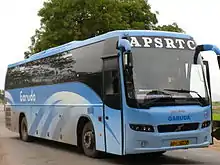Volvo B7R
The Volvo B7R is a coach chassis available with a range of bodies. It is promoted as a rear engined lightweight coach chassis. It is primarily intended for tourist and long-distance duties. B7R is also manufactured in China, Brazil, Hungary, India and Iran for use in regional transport services.
| Volvo B7R | |
|---|---|
 | |
| Overview | |
| Manufacturer | Volvo |
| Production | 1997–2019 |
| Assembly | Sweden: Borås (CBU) Brazil: Curitiba (CBU) Philippines: Subic, Zambales and Muntinlupa City (CKD) |
| Body and chassis | |
| Class | Bus chassis |
| Body style | Single-decker coach |
| Doors | 1 or 2 (3 in Malaysia include driver's door, 4 in Indonesia include driver's door and emergency door) |
| Floor type | Step entrance |
| Powertrain | |
| Engine | Volvo D7A/D7B/D7C/D7E |
| Power output | 290hp (D7E) |
| Transmission | ZF 6S1380BD manual 6-speed, ZF 6AP1400B automatic 6-speed |
| Chronology | |
| Successor | Volvo B8R |
B7R is powered by Volvo D7E (previously D7A, D7B and D7C) six-cylinder diesel engine with turbocharger and intercooler. The D7E engine produces 290 hp with 1200 Nm of torque between 1050 and 1650 r/min.
It comes with a retarder incorporated into the gearbox. The retarder slows down the engine when brakes are applied. Once the engine slows down, disk brakes take over and bring the vehicle to complete stop, almost in an instant.
Its frame is a robust steel construction with a flat upper face. A flat upper face simplifies building bus body. It could be built with a maximum length of about 12.5 metres.
The B7R is also available as complete buses - the Volvo 7350 (for Mexico), Volvo 9400 (for India) and Volvo 8700. The B7R is the most widely used deluxe long distance bus in India and is employed by not only the state-owned transport corporations of the state of Karnataka, Maharashtra, Rajasthan, Bihar and Andhra Pradesh but also by private operators.
Volvo also developed a low-floor variant of B7R, known as the Volvo B7RLE, for intercity and city operations.

In Brazil, B7R is produced in Curitiba since 1998. The first B7R in the country was imported from Sweden and operated in Curitiba's public transportation as a Direct Line Bus. In 2012, B7R was renamed to B290R (B7RLE was renamed to B290RLE), and is often used in BRS and BRT applications.
In the Philippines, B7R is also the basis for the GDW6127HKC and DMMW DM16 (included a Volvo 9800-styled front fascia) manufactured by Autodelta Coach Builders Inc and Del Monte Motor Works. It is similar to the low-end version, also the B7RLE.
Meanwhile, in Indonesia, the Volvo B7R only presented from 2003 to 2004. But there are many bus companies that use the Volvo B7R, such as PO. Harapan Jaya, PO. Nusantara, etc. In the operation, this bus was sometimes used as the regular route and sometimes used as a tourist bus. Using the Volvo D7E, this bus has large horsepower, compared with standard Indonesian busses in the rear-engined busses, such as Hino RK8JSKA, Hino RG1JS/JN, Mercedes Benz OH 1521, and Mercedes Benz OH 1525. But due to its large power and high maintenance, many companies that were using the B7R sold the bus or changed the D7E engine into a Mitsubishi Fuso 6D16 engine or Nissan Diesel FE6B or Hino J08E to reducing operational and maintenance cost.
.jpg.webp)
 Volvo B7R with an AGA polaris body, in Colombia, operated by the Libertadores service of coflonorte ltda
Volvo B7R with an AGA polaris body, in Colombia, operated by the Libertadores service of coflonorte ltda The GARUDA APSRTC Bus of Andhra Pradesh India
The GARUDA APSRTC Bus of Andhra Pradesh India The MSRTC coach in the state of Maharashtra India
The MSRTC coach in the state of Maharashtra India A Volvo coach of the Karnataka State Road Transport Corporation
A Volvo coach of the Karnataka State Road Transport Corporation Volvo B7R operated by Joanna Jesh Transport Corp. in the Philippines.
Volvo B7R operated by Joanna Jesh Transport Corp. in the Philippines.
See also
External links
| Wikimedia Commons has media related to Volvo B7R. |